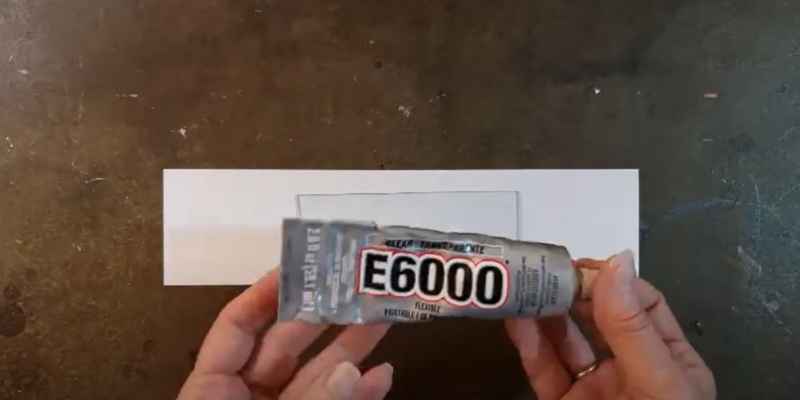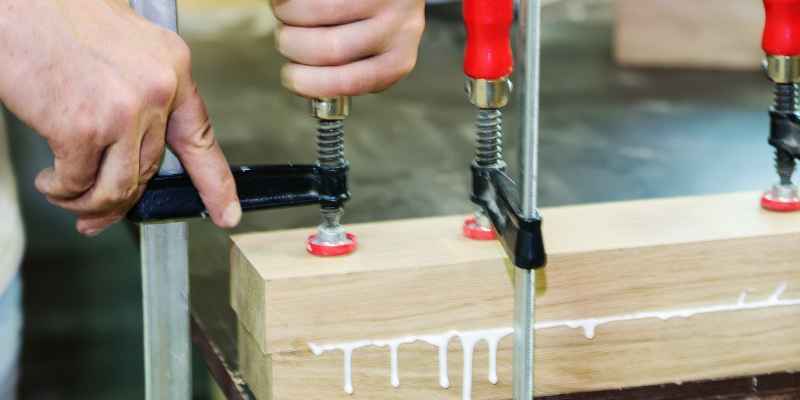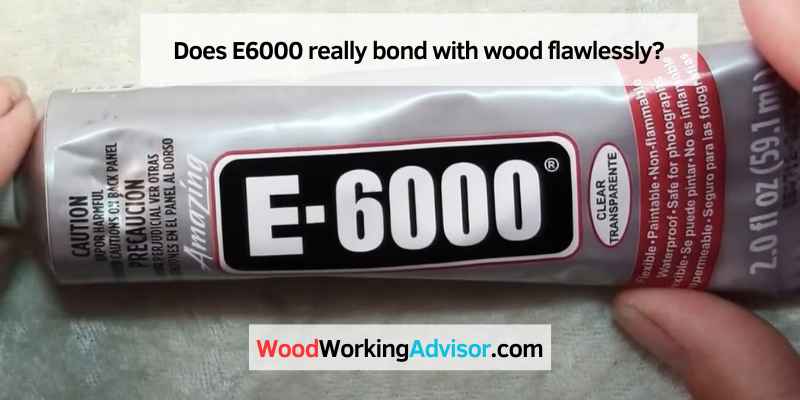Yes, E6000 works on wood for a variety of projects and crafts. E6000 is a versatile adhesive that is specially formulated to bond wood and other porous surfaces, making it an ideal choice for woodworking projects.
Whether you’re looking to attach pieces of wood together, repair furniture, or add decorations to wooden surfaces, E6000 provides a strong and durable bond that will hold up over time. Its ability to bond different types of wood and its resistance to temperature changes and moisture make it a reliable choice for woodworkers and DIY enthusiasts.
With E6000, you can confidently tackle your woodworking projects knowing that the adhesive will effectively bond wood surfaces.
Understanding E6000
E6000 adhesive is known for its versatility, and yes, it works on wood. This powerful adhesive provides a strong bond for various crafting and woodworking projects, making it a go-to choice for many DIY enthusiasts.
What Is E6000?
E6000 is a versatile adhesive that is widely used for various crafting and DIY projects. It is known for its exceptional bonding strength and flexibility, making it a popular choice among both professionals and hobbyists. This adhesive is suitable for a wide range of materials, including wood, metal, glass, fabric, and plastic.
Composition Of E6000
E6000 is a specialty glue formulated with a unique combination of chemicals, ensuring a strong and durable bond. Its composition includes:
- Polysulfide Polymer: This polymer provides excellent adhesion to different surfaces, ensuring a long-lasting bond.
- Aromatic Solvent: The aromatic solvent in E6000 helps ensure easy application and quick drying, making it convenient to use even on wood.
- Resin: The resin in E6000 contributes to its flexibility, allowing for movement without compromising the bond.
- Mineral Spirit: The mineral spirit aids in the easy spreadability of the adhesive, ensuring even coverage on the wood surface.
E6000’s unique composition gives it remarkable strength and versatility, making it an ideal choice for wood-related projects.

Bonding With Wood
E6000 is a versatile adhesive that is widely used for bonding various materials, including wood. One of the reasons why E6000 is popular for wood bonding is its excellent adhesion properties. It forms a strong and durable bond with wood surfaces, making it an ideal choice for a wide range of woodworking projects.
Unlike other adhesives that may not adhere well to wood surfaces, E6000’s unique formula allows it to effectively bond with different types of wood, including hardwoods, softwoods, and engineered wood. Whether you are working on a small craft project or a large woodworking project, E6000 can provide the reliable adhesion you need.
E6000’s adhesion properties stem from its ability to penetrate the porous surface of the wood and create a strong bond. This adhesive forms a flexible yet robust bond that can withstand various stresses and forces, ensuring that your wood projects stay securely bonded together.
Factors Affecting Bonding
While E6000 is known for its strong adhesion to wood, there are several factors that can affect the bonding process. Understanding these factors can help you achieve the best results when using E6000 on wood.
- Surface Cleanliness: Before applying E6000 to wood, it is crucial to ensure that the surface is clean and free from dust, dirt, and any contaminants. Clean the wood surface thoroughly and allow it to dry completely before applying the adhesive.
- Surface Texture: The texture of the wood surface also plays a role in the bonding process. Rough or porous surfaces provide more opportunities for the adhesive to penetrate and create a strong bond. If the wood surface is smooth, sanding it lightly can enhance the adhesion.
- Temperature and Humidity: Both temperature and humidity can affect the curing time and strength of E6000’s bond. It is advisable to use this adhesive in a well-ventilated area with a temperature range of 50°F to 90°F (10°C to 32°C) and moderate humidity levels.
- Pressure and Clamping: Applying pressure to the bonded wood surfaces can help improve the bond’s strength. Consider using clamps or weights to apply even pressure in an appropriate manner.
Preparing The Wood Surface
To ensure a successful bond between E6000 and wood, proper surface preparation is vital. The following steps can help you prepare the wood surface for optimal adhesion:
- Clean the surface: Use a mild detergent or cleaner to remove any dirt, grease, or other contaminants from the wood surface. Rinse thoroughly and allow the surface to dry completely.
- Sand the surface: If the wood surface is smooth or has a glossy finish, lightly sand it using fine-grit sandpaper. This step helps create a slightly rough texture, promoting better adhesion.
- Remove dust: After sanding, remove any dust particles using a clean cloth or a vacuum. Ensure that the surface is completely free from dust before proceeding.
Following these steps can enhance the bonding strength between E6000 and wood, ensuring a secure and long-lasting connection. With proper preparation and considering the factors that influence adhesion, you can confidently use E6000 for various woodworking applications.
Application Techniques
Proper application of E6000 adhesive is essential for achieving the best results when working with wood. Whether you are bonding wood to wood or wood to other materials, following the right techniques is crucial. Here are some tips to ensure a successful application:
Proper Application Of E6000
When using E6000 adhesive on wood, it is important to prepare the surface properly. Follow these steps for the best application:
- Clean the surface: Start by cleaning the wood surface to remove any dust, dirt, or grease. Use a mild detergent and water, then dry thoroughly.
- Sand the wood: If the wood has a smooth finish, lightly sand it to create a rougher surface. This will enhance the adhesion of the E6000 adhesive.
- Apply the adhesive: Squeeze a small amount of E6000 adhesive onto a disposable surface, such as a piece of cardboard or plastic. Using a toothpick or a small brush, apply an even layer of adhesive to the wood surface.
- Join the surfaces: Press the wood surfaces together firmly and hold them in place for a few minutes to allow the adhesive to bond.
Tips For Best Results
To achieve the best results when using E6000 adhesive on wood, consider the following tips:
- Work in a well-ventilated area: E6000 adhesive has a strong odor, so make sure you have proper ventilation when using it.
- Use the right amount: Apply a thin layer of adhesive to the wood surface. Using too much adhesive can result in slower drying times and excessive seepage.
- Allow for curing time: E6000 adhesive requires time to cure fully. Follow the manufacturer’s instructions for the recommended curing time before subjecting the bonded surfaces to stress or pressure.
- Store properly: Keep the E6000 adhesive tightly sealed when not in use and store it in a cool, dry place. This will help prolong its shelf life and maintain its effectiveness.
By following these application techniques and tips, you can ensure that E6000 adhesive works effectively on wood, providing a strong and durable bond.

Challenges And Limitations
Although E6000 is a popular adhesive known for its versatility and effectiveness, it does have its challenges and limitations when it comes to bonding wood. In this section, we will explore some of the difficulties you may encounter when using E6000 on wood and alternative adhesive options to consider.
Difficulties In Bonding Certain Types Of Wood
Bonding different types of wood can pose a challenge when using E6000. Some types of wood, such as oily or resinous woods, may not provide a suitable surface for the adhesive to bond effectively. This can result in weak or unreliable bonds that may not withstand the test of time.
Additionally, rough or uneven wood surfaces may hinder the adhesive’s ability to create a strong bond. When working with rough wood, ensuring proper surface preparation is crucial to enhance the adhesive’s effectiveness. Properly sanding or smoothing the wood surface before applying E6000 can improve the bonding results.
Problems With Durability
While E6000 offers excellent initial adhesion, some users have reported issues with long-term durability when using this adhesive on wood. Over time, certain environmental factors, such as temperature fluctuations or exposure to moisture, can weaken the bond between the wood and the adhesive.
Moreover, the nature of wood movement can further impact the durability of E6000 bonds. Wood expands and contracts with changes in humidity, which can put stress on the adhesive joint. If the adhesive lacks the flexibility to accommodate these movements, the bond may eventually fail.
Alternative Wood Adhesive Options
If you’re facing difficulties or concerns with using E6000 on wood, there are alternative adhesive options worth considering.:
- Cyanoacrylate (CA) adhesive: Also known as super glue, CA adhesive can bond wood quickly and effectively. It forms a strong, instant bond and works well on different types of wood surfaces. However, it’s important to note that CA adhesive has little to no gap-filling ability, so a precise fit is necessary for successful bonding.
- Polyurethane adhesive: Polyurethane adhesives are known for their excellent bond strength and durability. They can withstand a wide range of environmental conditions and are particularly suitable for bonding wood surfaces. These adhesives also have some gap-filling properties, making them ideal for uneven or rough wood surfaces.
- Wood glue: Traditional wood glue, such as PVA or aliphatic resin glue, remains a reliable option for bonding wood. Wood glue is known for its strong bonds and is specifically formulated for woodworking projects. It offers good gap-filling properties and is suitable for a wide variety of wood types.
When choosing an alternative wood adhesive, consider factors such as the intended use, the type of wood you’re working with, and the specific requirements of your project. Conducting proper research and testing different adhesives can help you find the most suitable option for your woodworking needs.
Conclusion
E6000 is a reliable adhesive that works effectively on wood surfaces. Its strong bonding properties make it a popular choice for woodworkers and DIY enthusiasts. Whether you’re repairing furniture, crafting wooden projects, or creating intricate designs, E6000 provides a sturdy and long-lasting bond.
Its versatility and easy application make it a go-to adhesive for all your woodworking needs. Trust E6000 to deliver exceptional results and bring your wood projects to life.


